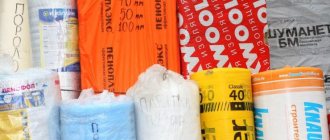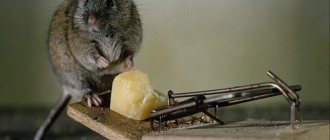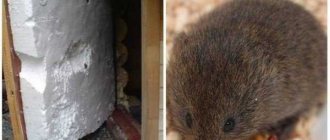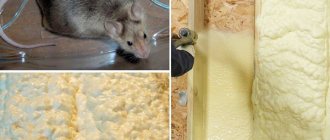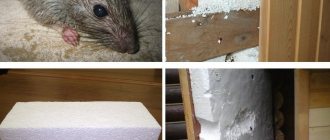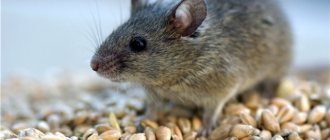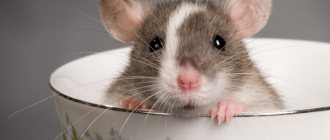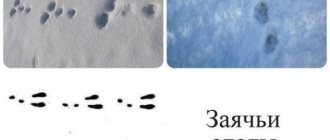When building a house, a lot of money is spent on its high-quality thermal insulation. But often all these expenses turn out to be in vain, and the reason for this is not always non-compliance with the technology of thermal insulation work, due to which the insulation gradually loses its properties. Often it is damaged by rodents, making through passages and holes in the warm “fur coat” and thereby opening the access of cold air to the walls and other structures. If you know which insulation is not chewed by mice and rats or how to protect it from them, these problems can be avoided.
The main rule of thermal insulation is the absence of cold bridges in the insulation Source domaleto.ru
Popular insulation materials and their disadvantages
Nowadays, the most popular thermal insulation materials for walls, floors and ceilings are polystyrene foam and mineral wool in various variations. They are valued for their light weight, ease and speed of installation. Indeed, their installation takes much less time than plastering wooden walls with clay mixed with straw or sawdust. And it can be done without any special physical effort. And the efficiency of such thermal insulation is significantly higher as a result.
However, these popular materials, among other disadvantages, have one serious disadvantage: they are liked not only by home owners, but also by rodents, as they are an excellent warm and safe refuge for them. This does not mean that you need to abandon them and look for which insulation does not harbor mice and insects. Moreover, it is difficult to find an alternative to mineral wool and PPP in terms of price/convenience/efficiency ratio. You just need to think about reliable protection of the thermal insulation layer from unwanted attacks.
It’s easier to keep rodents out of your home than to evict them Source hemingpestcontrol.com
We'll tell you how to do this later. There are many such methods and they all work quite well. But to be able to make an informed choice, it is necessary to have complete information about all insulation methods if someone still wants to use insulation that is not chewed by mice.
Modern technological processes
The starting material is melted in a cupola furnace at a fairly high temperature of 1000-1500 degrees. After the fiery-liquid mixture is obtained, the moment of drawing out the fibers comes.
The current process uses the following technologies:
- blowing;
- centrifugal roller;
- centrifugal-blown;
- other modified methods and techniques.
Examining the structure in detail, we come to the conclusion that these are chaotic fibers, the lengths of which are completely different, the thickness fluctuates within normal limits, drawn from glass waste.
In terms of heat capacity, they differ slightly from each other. Due to the fact that the fibers are able to create an air cavity, which in turn fixes the air in a stationary state, the material is so popular. Although before purchasing, the buyer is interested in the question of whether mice chew it or not?
Rodent resistant materials
Rats and mice, trying to get into a house where it is warm and nourishing, can even gnaw through wood, not to mention less dense materials. They do not eat the insulation, but remove the obstacle that prevents them from reaching the target. Or they make warm nests in it, protected not only from the cold, but also from natural enemies who are unable to reach them through enclosing structures and narrow cracks.
Therefore, there is no need to doubt whether mice live in mineral wool. They live well, breed and reach living quarters in search of food. Because this material, like polystyrene foam or polyurethane foam, is easy for their teeth and does not cause any harm.
Nest with brood in insulation Source city-michurinsk.rf
To prevent rodents from damaging the insulation, the material must be either very hard, poisonous to them, or unsuitable for habitation. And such insulation systems exist.
Foam glass
Since foam glass (or foam glass) is not the most common and little-known thermal insulation material to the average consumer, it is worth talking about it in more detail.
The low popularity of the material is explained by its high cost. It is produced from broken glass and glass production waste by melting and foaming the molten mass. Air bubbles enclosed in the cells of the material retain heat well. This is insulation that is not chewed by mice and is not afraid of moisture, as it has a very solid structure and mineral origin. Available in the form of slabs, blocks or loose granules.
The color of the material is gray, granules and crumbs are similar to expanded clay Source hemix.com
- Foam glass blocks and slabs are used to insulate facades; they can be plastered or tiled.
- Loose form of foam glass is used for thermal insulation of floors and ceilings
In addition to the listed advantages, foam glass has other advantages. Unlike cotton insulation, it does not shrink or change shape. It does not harbor insects and harmful microflora. And in terms of durability it surpasses all known thermal insulation materials.
Bulk insulation
Bulk insulation materials that are not damaged by rodents include expanded clay, vermiculite, and perlite.
Vermiculite and perlite are insulation materials in which rodents do not live. It is made from molten and foamed rocks of volcanic origin. Simply put, this is sand processed in a certain way. Therefore, it has much in common with granular foam glass and has similar properties and characteristics. Vermiculite differs from perlite only in that additional mineral additives are introduced into its composition.
White – perlite, colored – vermiculite Source gardensavvy.com
See also: Catalog of companies that specialize in home insulation
Expanded clay is a lightweight porous material made from clay fired at high temperatures. Depending on the size and shape of the particles, they are divided into:
- expanded clay gravel in the form of smooth round pellets with a diameter of up to 40 mm;
- expanded clay crushed stone in the form of crushed pellets of irregular shape with sharp edges;
- expanded clay sand – screening of crushed stone and gravel or crushed fine material.
To understand whether mice breed in expanded clay or other similar insulation, it is enough to imagine rodents trying to chew hard granules. Even if they succeed, the passage will immediately be blocked by another particle of moving material. It won't be possible to make a hole in it either.
In addition, a thick layer of bulk insulation does not allow air to pass through well; there is simply nothing to breathe in it. Vermiculite generally has the ability to absorb odors, and mice and rats try not to detect themselves by the trail of their own aromas, so they will not linger in it.
By insulating the floor with expanded clay, you don’t have to worry about mice settling under it. Source pol-exp.com
Despite the fact that expanded clay and mice are incompatible concepts, such insulation is not the most popular. They can only insulate horizontal structures or be used as backfill in double masonry. And for effective thermal insulation you need a fairly thick layer of material, so it is mainly used to insulate ceilings in attics and the floor of the first floor.
Ecowool
Ecowool by its name alone indicates the natural origin of the raw material. Indeed, it is shredded paper waste, and mice not only gnaw paper, but also eat it with pleasure. However, in production, this insulation is impregnated with brown acid, orthophosphoric acid and other substances that are safe for humans, but harmful to rodents and insects. When they enter the body, they cause severe thirst, and in the absence of water in close access, the mice cannot stand it and give up trying to settle in this soft and warm material. Therefore, we can say that ecowool is an insulation material that mice and rats are afraid of, despite its natural composition.
Why do mice need foam?
Holes and depressions caused by mice in construction foam are not uncommon. Of course, they are unlikely to like the taste of polyurethane foam, especially when more tasty, natural materials or products can be found nearby.
In fact, mice chew foam for the following reasons:
- Building nests. Animals like to make holes and beds inside the warm, light material, and carry pieces of it into their holes.
- Grinding of teeth. Mice's teeth constantly grow throughout their lives, and they definitely need to sharpen them. If polyurethane comes into contact with rodents, they will sharpen their teeth on it, along with furniture and wood.
- Construction of passages. Inside the foam layer, mice will be able to fearlessly walk around the home and move to different parts of it. To do this, they gnaw long and wide passages. Doing this in foam is an order of magnitude easier than in concrete or brick.
Mouse nest under the windowsill
Video description
An example of how mice “taste” the insulation, but do not stay in it, in this video:
However, rodents can gnaw passages in ecowool to get to more “edible” material. How can they build nests in insulation that was produced in violation of technology and is not impregnated with special compounds.
Ecowool is considered one of the best thermal insulation materials, as it is installed without seams, is not afraid of moisture and has good fire resistance due to fire retardant impregnation. Its disadvantages are the difficulty of installation by spraying and large shrinkage when installed in bulk.
Option #3. Ecowool
In order to avoid mice settling inside the insulating material, many experts advise using ecowool for thermal insulation purposes. This material is relatively “young”, however, it has already managed to take an honorable place among effective and frequently used heat insulators. The installation procedure for ecowool involves the use of special equipment that helps in distributing the insulation over the treated area. And as soon as the material initially sets, the layer must be leveled using a special roller.
You may be wondering: why don’t rodents eat ecowool? After all, it is soft, therefore, it will easily yield to the teeth of animals. But the whole secret why rodents don’t “like” ecowool is that its production uses orthoboric acid, which causes serious consequences in these animals (from dehydration to suffocation). Perhaps some individuals will make attempts to make a nest there, but they will not live long, and they will not be able to reproduce, which is why they will soon leave such a cozy, it would seem, place.
As noted above, this insulation is treated with orthoboric acid, which has antiseptic properties. At high temperatures, the material releases moisture, due to which it has excellent fire-fighting characteristics. The raw material in the production of ecowool is cellulose, and it is known to be completely harmless to the human body. It is for this reason that it is possible to insulate not only the external walls of the building, but also the internal surfaces, distributing the insulation between the beams of the sheathing equipped for this purpose.
The thermal conductivity of this insulation is low, as well as sound conductivity, therefore, it perfectly retains heat in the room and muffles all sounds that come from outside or from adjacent rooms (if we are talking about insulating interior walls). Finally, ecowool will serve you for many years, because over time it does not decompose or rot.
Video - What you need to know about ecowool
Insulation with foil
Previously, we talked about how and where to use insulation with foil; in addition to this article, we advise you to read this information and read about it here
How to protect insulation from rodents
Having chosen mineral wool or polystyrene foam boards as insulation, you need to think in advance, even before installing it, about measures to protect it from rodents. Some developers use glass wool, believing that small particles of glass will repel mice. In fact, mice also live in glass wool, because they do not eat it. You don’t even have to gnaw on the loose material – it easily bends under the weight of the animals, and they can squeeze through the slightest crack. Therefore, you just need to keep them out of the insulation or scare them away.
Metal mesh barrier
Fine-mesh steel mesh is a reliable barrier for mice. It can be attached to joists and floor beams when insulating the floor, to frame posts when thermally insulating walls under a curtain wall. If the walls are plastered, the mesh will serve not only as protection against pests, but also as a reinforcing frame. But in this case it is better to choose galvanized products.
Do they chew roofing felt?
Another material that is too tough for pests is roofing felt. Its resistance to rodents is evidenced by numerous reviews from builders and household owners.
Instead of roofing felt, you can also use roofing felt, which has a specific smell that repels mice and rats. The only drawback of roofing felt is the absorption of foreign odors. However, this problem can be eliminated by installing a reliable film inside the insulation.
Thermal insulators with a strong structure - foam concrete, expanded clay or roofing felt - are resistant to the effects of rodents. Mice cannot settle inside materials and enter a person’s home.
Heat insulators containing mineral fibers: mineral, stone and basalt wool are considered relatively safe for insulating houses. Mice and rats will not consume mineral fibers as food, but if desired, they can damage them and make passages and holes in the material.
For thermal insulation at home, it is not recommended to use organic insulation and low-density materials: reeds, sawdust, polystyrene foam. They will not protect your home from rodent infestation.
Briefly about the main thing
Without high-quality thermal insulation, it is difficult to create normal living conditions in a house so as not to freeze in winter, spending a lot of money on heating, and not swelter from the heat in summer. But the effectiveness of the insulation may come to naught if there are mice in it. They are not at all attracted to foam glass, expanded clay, penoizol and cellular concrete insulation, but these materials have too many disadvantages compared to such modern insulators as mineral wool and expanded polystyrene. Therefore, you need to know what ways you can protect them from rodents or scare them away.
Recommended methods for controlling domestic rodents and insects
Damaged areas of insulation are permanent cold bridges that can cause damp spots on walls and ceilings. A consequence of an increase in the rodent population may be the façade finishing of a house, the basement, or the insulation of the foundation on screw piles.
- It is easier to prevent mice infestation at the stage of installing polystyrene foam cladding. The problem is partially solved by sealing the installation joints with durable acrylic putties.
- Covering areas of foam insulation accessible to rodents with durable cladding gives good results. This can be thin-walled metal, basalt mesh or wood-polymer finishing panels.
- Cats take an active part in exterminating the mouse population. Decorative breeds, in particular Siamese, Angora and exotic Egyptian breeds, practically do not react to mice. The best option for a full-fledged mousetrap is a yard cat or a cat that does not pretend to have a high breed status.
In the fight against ants, baits based on boric acid, which is safe for health, are traditionally relevant.
Read our publication on what to choose for thermal insulation of the foundation: polystyrene foam or polystyrene foam.
Why do mice chew inedible things, including different types of insulation?
Some types of insulation are considered conditionally edible for rodents, for example chipboard, reeds and polystyrene. By eating them, rats compensate for a long absence of food. The organic materials from which the insulation is made are perfectly digested and absorbed in their stomachs. Mice can chew polyurethane foam, fiberboard, MDF, and polyurethane foam, and this is due to their physiological characteristics. Rodents' incisors grow throughout their lives, so they have to be ground down regularly.
Not only thermal insulation materials are damaged, but also shoes, clothing, furniture, and wiring. Most of all, mice like to live in jute, inside mineral or basalt wool. The soft material holds its shape well, is ventilated and retains heat well. Treatment with special chemicals or boric acid will help protect the insulation from damage. Plywood and DSP boards, which are excellent for insulating a frame house, are not always susceptible to mouse teeth.
Chemical activity
Of particular note is its low chemical activity. This is another positive side of the material, since it is not influenced by many compounds:
- alcohol-based paints;
- different types of acids;
- salt solutions;
- chlorine;
- various oils and paraffins;
- cement mortars.
But there are also substances, although there are not many of them, that, when interacting with penoplex, can cause it to change shape and even dissolve.
When insulating the adhesive for work, it is important to choose the one indicated in the instructions
This is important: when choosing a solvent for painting, you should carefully study the instructions in order to avoid deformation and shrinkage of the material
Ecowool insulation: production secrets
Manufacturers of ecowool strongly emphasize the unconditional environmental friendliness of the material. The extent to which this statement is unconditional can only be judged from the composition of the additives used to process shredded paper. Fire retardants, substances that make ecowool resistant to fire, are not very beneficial for human health, although the paper itself, of course, cannot cause any harm.
It cannot, but in the case when it is reliably known that it is not newspaper sheets that are being shredded, since with the printing method of applying paint, such paper necessarily contains a small percentage of lead. If this fact is not taken into account, then, indeed, paper can be considered completely environmentally friendly. Manufacturers do not always disclose the composition of fire retardants and additives to increase fire resistance.
Protecting your home during renovations
During the period of renovation work, the house is always in chaos. And the presence of heaps of construction waste near the home becomes an excellent refuge for rodents.
Repairs can very often be delayed and last from several weeks to several months. During this entire period, it is important to defend the house and not let mice inside, so you must adhere to the following recommendations:
- promptly remove construction waste and remove it outside the local area;
- leave several rodent traps in different parts of the house;
- install repellent devices indoors.
